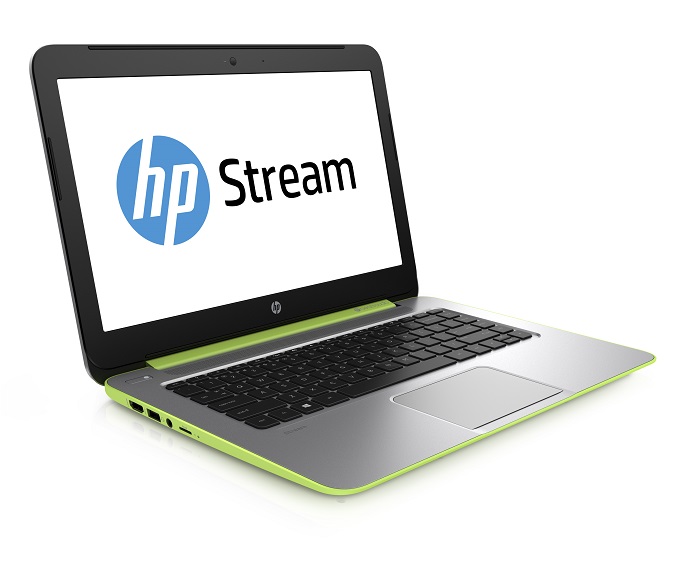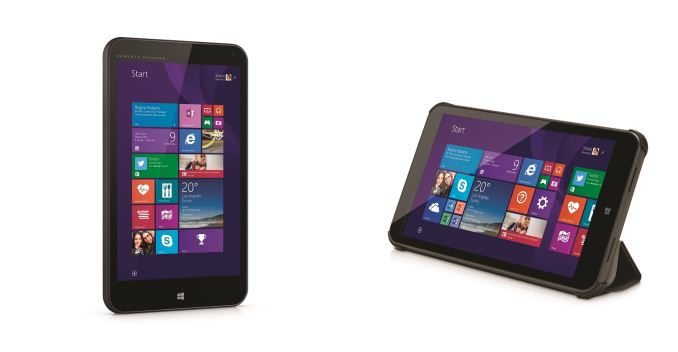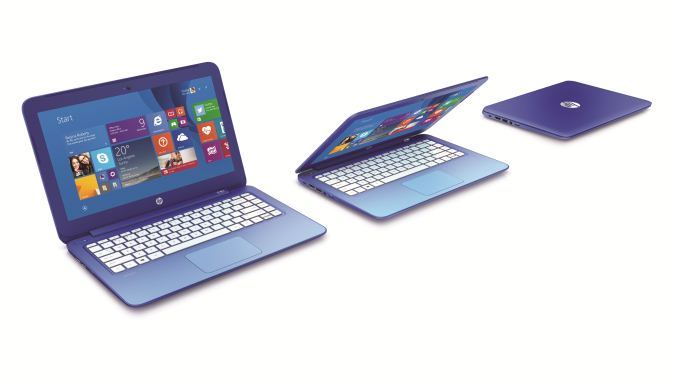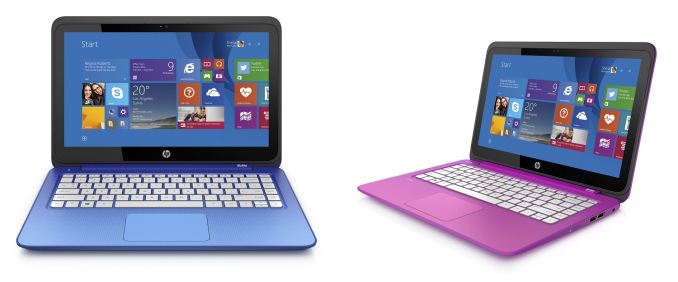HP Announces Low Cost Stream Laptops And Tablets
by Brett Howse on September 29, 2014 11:30 PM EST
Several weeks ago, Hewlet-Packard announced the HP Stream 14” Notebook. The Stream series is HP’s version of the low cost Windows laptop, meant to compete head to head with Chromebooks on price, but still offer the power of a fully fleshed out operating system. The Stream 14 (pictured above) is available to purchase now for only $299, and comes with an AMD A4 APU, 2 GB of RAM, and 32 GB of eMMC storage.
Today, HP revealed the rest of the Stream lineup, with two additional laptops, and two tablets. In a world where the Chromebook has put some serious price pressure on the Average Selling Price of low cost computing, OEMs are trying to win over consumers with nice designs and additional perks in an effort to differentiate from the competition.
First up is the laptops. There are two screen sizes with the smaller being 11.6” and the mid-size being 13.3”, to compliment the already released 14” model. Exact specifications have not been disclosed yet, but both units will be powered by an Intel dual-core Celeron processor based on the Bay Trail architecture. This will make it a fanless device, and both come with 2 GB of RAM and 32 GB of eMMC storage. The 13.3” device has an optional touchscreen to go with the 1366x768 resolution that both laptops share. The 13.3” model also is available with optional 4G connectivity, and as a value add, HP is including 200 MB of free data every month for the life of the device. As another value add, HP is offering one year of Office 365 personal, which includes 1 TB of online storage and 60 Skype minutes per month. Battery life is listed from HP at 8:15 for the 11.6” model, and 7:45 for the 13.3” model. The HP Stream laptops are available in several colors, and will be priced at $199.99 for the 11.6” model and $229.99 as the starting price for the 13.3” model.
With the race to the bottom on pricing, one has to wonder where it will end, but all we know is it has not ended yet. Today HP also announced the HP Stream 7 Tablet, which is a 7” Windows 8.1 with Bing device that comes in at only $99.99. If you are in need of a slightly larger device, with optional 4G, then HP also has you covered with the HP Stream 8 which has a starting price of $149.99. Both tablets are powered by Intel Atom quad-core processors, and 1366x768 screens. Like the larger of the two laptops, the 8” tablet, if equipped with the optional 4G, comes with 200 MB of data per month for the life of the device, and both also come with Office 365 personal for one year. Office 365 personal is $70 to purchase on its own, so for only $30 more you can get it with a 7” tablet.
 HP Stream 7 (left) HP Stream 8 (right)
HP Stream 7 (left) HP Stream 8 (right)
It has been a bit painful to see the thin and light Chromebooks popping up over the last couple of years, and it was always especially frustrating that low cost Windows laptops were large, thick, noisy, and had very slow spinning hard disks. It is great to see the Chromebook styling now coming to Windows PCs, and with the Chromebook pricing as well. Microsoft is making a big push to recapture some of this end of the market by offering Windows 8.1 with Bing, and they are now starting to see some examples of great looking Chromebook competitors.
The tablet side is not as rosy, with Windows 8.1 not having the same mobile ecosystem as Android, but at least the pricing is now in line for the bottom end of the market. The add-ons offered by HP are pretty strong, with the Office 365 Personal costing almost as much as the tablet itself, and 4G for life is a nice bonus to those who just need a bit of data when they are not on Wi-Fi. Of course what the Windows Tablets need as the killer app is the touch version of Office, but that is not available as of yet, so anyone who wants to take advantage of Office 365 will have to do it from a 7-8” desktop, but as with most Windows tablets these can be connected to a keyboard, mouse, and monitor if you were so inclined. This is a strong push by HP to get a foothold in the low end of the market, with sharp looking products and useful value adds as well. Hopefully we can get some of these as review units to give you the full break down on just what you get for so little money.
Source: HP












49 Comments
View All Comments
Minion4Hire - Tuesday, September 30, 2014 - link
You are quite correct. Reading too quickly. And also assuming cheap tablets = RT.If Microsoft fully abandons the RT environment the world will be a better place.
Andrew7783 - Saturday, October 4, 2014 - link
I think they pretty much have abandoned RT. I think pretty much every Windows tablet released in the last year, even budget ones, have had full 8.1.bakedpatato - Tuesday, September 30, 2014 - link
I can't find the reference in the WHQL docs (http://msdn.microsoft.com/en-us/library/windows/ha... but IIRC if you have mobile broadband in order to pass Windows 8 logo cert you need to have an A-GPS. as you noted most broadband chips come with GPS anyway as A-GPS needs an internet connection to work it's best.timon_comment - Tuesday, September 30, 2014 - link
Comparison Atom processors by Intel arkModels, Clock Speed/Burst Frequency, Memory Size/Bandwidth, SDP, TRAY (Sep 6 2014)
Z3740, 1.33 GHz/1.86 GHz, 4 GB (dual-channel)/17.1 GB/s, 2Watt, $ 32.00
Z3745, 1.33 GHz/1.86 GHz, 4 GB (dual-channel)/17.1 GB/s, 2Watt, $ 30.00, (somewhat castrated)
Z3745D, 1.33 GHz/1.83 GHz, 2 GB (single channel)/10.6 GB/s, 2.2Watt, N/A, (somewhat castrated)
Z3735F, 1.33 GHz/1.83 GHz, 2 GB (single channel)/10.6 GB/s, 2.2Watt, $ 17.00, (more castrated)
Z3735G, 1.33 GHz/1.83 GHz, 1 GB (single channel)/5.3 GB/s, 2.2Watt, $ 17.00, (badly castrated)
Intel will never give you a pie cheaper and without a cause, some features:
Only for Z3740, Intel Quick Sync Video
Only for Z3740, Intel Clear Video HD Technology
Only for Z3740, Intel Insider (Intel Insider delivers premium HD content to an UltrabookTM or PC)
Only for Z3740, Secure Key
Only for Z3740, Anti-Theft Technology
Only for Z3740 and z3745, Intel Wireless Display (WiDi)
Only for Z3740 and z3745, Intel Identity Protection Technology
Only for Z3740 and z3745, AES New Instructions
Also,
The I/O total number of the Z3735F and Z3735G have been reduced to 367 from the 620+ (z3740).
The image processor, audio ports are reduced to two from three.
Video decoding and encoding are originally the four 1080p, three / one 4K but reduced to two 1080p.
Also, USB 3.0, USB HSIC, LPC are no longer supported.
USB 2.0 has also reduced to 2 x host and 1 x device from the 4 x HCI.
The 7 x I2C and 2 x SPI of the low-power port was reduced to 5 x I2C and 1 x SPI.
The Video output is also greatly diminished.
In the lowest-end 8" Windows tablets The WiFi does not support 5 Ghz, and with the cheapest low-end chips come from Formosan vender, like Realtek WiFi and Bluetooth module, etc..., or even is no GNSS/GPS, nor an HDMI port. And use a worse quality screen.
Currently these 8-inch Windows 8.1 tablets, Toshiba WT8-A 32GB/64GB ( dynabook tab VT484) is still a better choice, although not perfect enough, (launched in the end of 2013), GNSS/GPS, HDMI, e-Compass provided. (Note: this is not Encore 2 WT8-B this fall)
Toshiba VT484/WT8-A gotten the decent components and parts inside, Atom z3740 comes with dual channel memory (2x64bit) maximal 4GB, which the VT484/WT8-A employs 2x1GB modules, say the WLan, Bluetooth and GNSS are all of Broadcom chips, and WiFi supports for 2.4Ghz and 5Ghz.
Related read
http://forums.toshiba.com/t5/Encore-Tablets/Encore...
AppleCrappleHater2 - Tuesday, September 30, 2014 - link
A recent unfortunate event, that obviously did not happen to me, sort of filled my cup of bitterness regarding HP, as a company, but most of all as a laptop manufacturer (stay far from their printers too). During the last 7 years, I’ve seen people cry, sware, go red, blue, then green, all of which while holding an HP laptop in their trembling hands. Most of the time, it’s already been the n’th problem they were experiencing with their “beloved” HP. During all these 7 years, I’ve fixed and chucked out more HP’s than all the other brands all-together. It first I was like “ok, unfortunate coincidence”, which then turned into “weird” and finally “this gotta stop!”Now, as much as this seems to some of you like a counter-campaign against HP, it’s not. It is merely sharing my 7 year experience, putting all the pieces together and proving why HP is NOT a good choice. I could turn this into “vs. article”, and say go buy DELL, Sony Vaio, Toshiba or ASUS. I am not going to do that. The choice is still going to be your’s, and I certainly don’t want to promote other laptop manufacturers either. It’s not my goal. My goal is to paint a real picture of HP and their omnipresent laptops.
Lots of you have HPs. Why? Everybody sells them. You can buy an HP at Tesco’s for God’s sake. It’s one of the biggest manufacturers on this God-forsaken planet. BUT biggest does not = best. It’s amazing how few people get that. Biggest does NOT = best! Remember Pioneer and NEC optical drives? No. Well, those were one of the best, while most of you had problems with LG and Asus, which at that time were the biggest in the optical drive industry. The fact that someone makes something in humongous volumes, does not imply or mean, they’re actually doing a very good job. Stop thinking that because HP is so well-known, it must also be damn good, or even the best.
Price-wise HP, while apparently ranks well, it’s kind of a lie, and it does not. True, you do find really cheap HPs, which are in fact Compaq Presarios (300-400$), on the market, but that does not make an entire line of products a good choice. Just during the last year I’ve seen 3 HP Pavilions go nuts out of the blue. One of those was irrecoverable. Mind you, those were expensive laptops (900-1000 euros). Mother-board crashes, BIOS fails, CPU stops working, fans go rogue, screen goes into labour and dies on the table, and I could continue. Sure, all laptops face these problems, more or less. I am not saying these are strictly HP issues (although some actually are), but the sheer number of unsatisfied and disappointed HP customers is way beyond acceptable. Yes, I’ve seen DELLs HDD or RAM die, yes I did. No manufacturer is perfect. No electronic device is perfect. Hell, I’ve seen all sorts of defects on all laptop manufacturers, but losing a HDD (if you have sensitive and important data, learn to back-up) or RAM is so not a big problem, compared to losing the laptop itself. HDDs and RAMs are the cheapest, and can be replaced by almost anyone who has minimal hardware knowledge.
HPs are so mass-produced that they seem to completely fail when it comes to quality and durability. Opposed to general belief, people do not buy a laptop every 2 years. Most of us like and hope to use it for around 4-5 years, and when you spend 800 or 1000 grand on a device, that expectation is more than justifiable. HP users tend to double that amount, or at least live a life full of frustration and the physical absence of the laptop itself considering the amount of time it spends in service. With an unjustifiable price, that also comes with almost assured tears and frustration, probably even the price of some new component if not the price of another laptop itself, HP not only that it does NOT seem like a good choice, but an extremely risky one as well. Unless it’s really cheap and has good warranty (2-3 years), under no circumstances do I see HP laptops as being a logical, technically and economically sane choice.
So, to answer the question in the title, HP is too mass-produced to still be able to offer quality over quantity. Also, in reality it’s never been as good as some folks try to convince their clients. You always hear HP this, HP that, the brand-name is out there, but ask yourself, how often was it about how durable or high quality their laptops are. Going with HP is a risky step, far riskier than going with a Toshiba or DELL. That step is certainly your’s to take, but ask yourself, what’s more important, to have an HP laptop or a good laptop?
Minion4Hire - Tuesday, September 30, 2014 - link
This was needlessly long.It is likely that you are suffering from some sort of confirmation bias. The fact that you repair a lot of HP computers does not mean they intrinsically have the highest failure rate. But it does mean that a lot of people buy HP computers.
Once upon a time I worked in a Dell call centre. Some people there were convinced that Dells were horrible because all they heard all day were callers with broken laptops. Of course that's your experience, because that's your job!
It's silly to state that the largest PC manufacturer also has the highest number of failures. That should be expected.
Rocket321 - Tuesday, September 30, 2014 - link
Since you mentioned "the last 7 years" I have to bring up "solder gate" (the use of faulty solder on HP motherboards) - I know of tons of HP laptops that failed from the faulty solder (issues presented in a very specific way), which HP never admitted to and generally wouldn't repair. I got burned on HP (plus they killed Palm!) so I'll look elsewhere. Also, everyone needs to stop making those awful 1366x768 screens. Like, literally, just stop making them.bsd228 - Wednesday, October 1, 2014 - link
No - he's right. HP is in a league of its own for crap. No other brand is more closely associated with the phrase "notebook cpu fan that will never shut up."nandnandnand - Tuesday, September 30, 2014 - link
Bay Trail sounds a lot more interesting than an A4. But how do they compare on graphics?nathanddrews - Tuesday, September 30, 2014 - link
Overall, Atom is much more powerful than anything ARM currently offers, but the GPU is a little weak. Better to wait for Cherry Trail.http://www.anandtech.com/bench/product/1212?vs=120...
http://www.anandtech.com/bench/product/999?vs=973